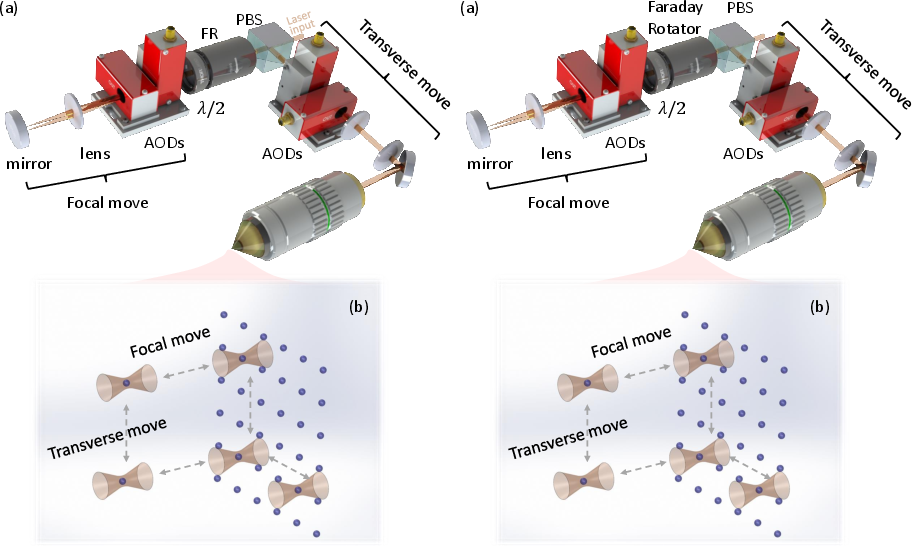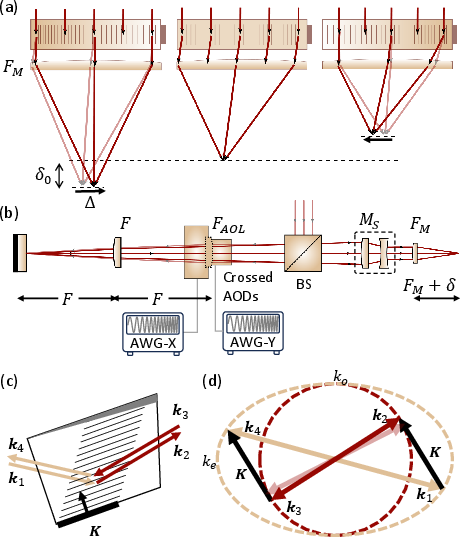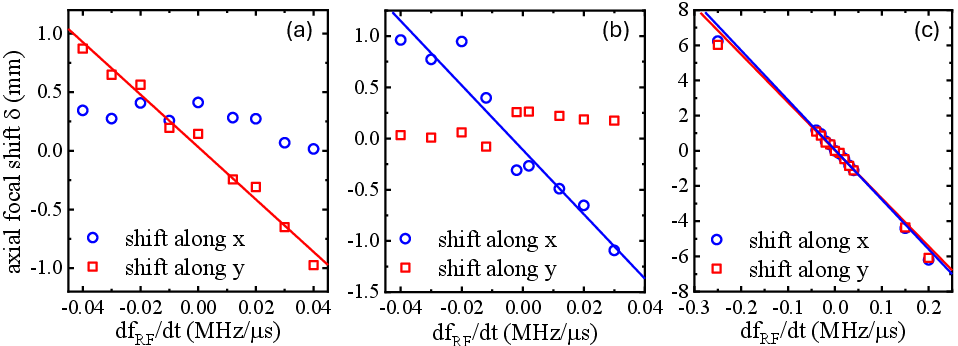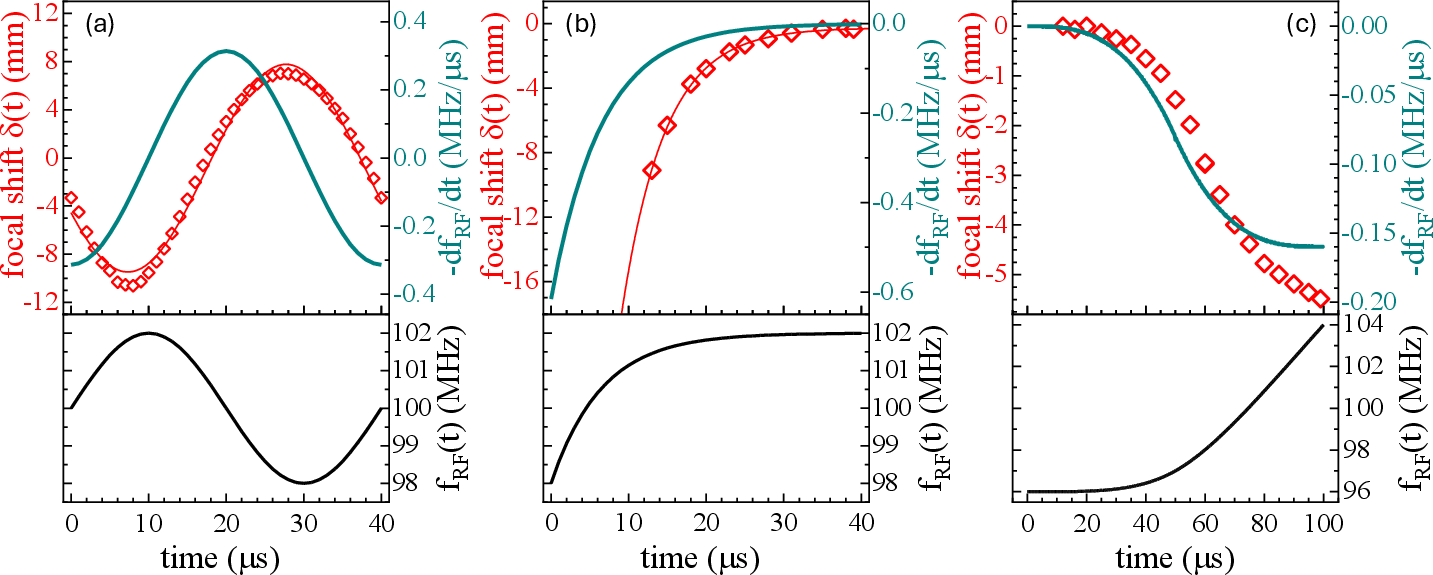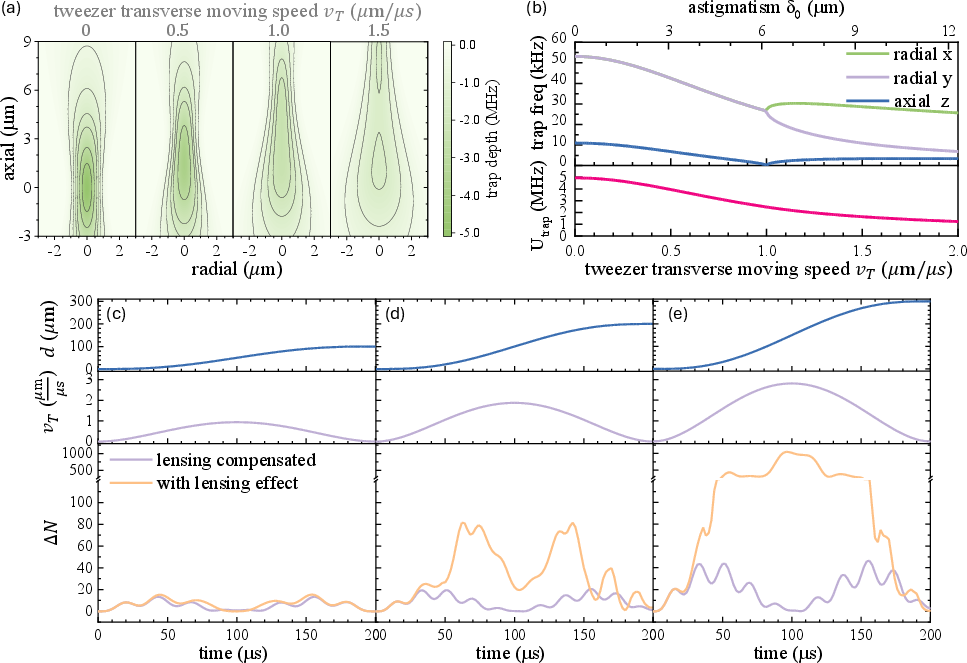Acousto-optic lens for 3D shuttling of atoms in a neutral atom quantum computer (2510.09398v1)
Abstract: We present a novel acousto-optic lens (AOL) design for neutral atom quantum computing. This approach enhances atom rearrangement in optical tweezer arrays and addresses the speed limitations imposed by the cylindrical lensing effect of acousto-optic deflectors (AODs). By combining a double-pass AOD configuration for dynamic focal tuning with a standard pair of crossed AODs for transverse beam steering, our design enables the generation of arbitrary focal point trajectories. This configuration enables shuttling of atoms in 3D space, thereby helping to realise fully connected two-qubit gates and mid-circuit measurements. We detail the optical implementation, characterize its performance, and discuss its applications in scalable quantum computing architectures.
Paper Prompts
Sign up for free to create and run prompts on this paper using GPT-5.
Top Community Prompts
Explain it Like I'm 14
Overview
This paper is about building a better “lens” made from sound and light so a neutral‑atom quantum computer can move its atoms around quickly and safely in 3D. The authors designed and tested a new acousto‑optic lens (AOL) that lets a laser tweezer move an atom not just sideways in a flat plane, but also up and down, like a tiny 3D crane. This helps with rearranging atoms, running two‑atom logic gates between any pair of atoms, and measuring some atoms mid‑computation without disturbing others.
Key objectives and questions
To keep it simple, the researchers set out to:
- Make laser tweezers move atoms in full 3D, not just in a single flat layer.
- Avoid a known problem: when you steer light quickly with acousto‑optic deflectors (AODs), they act like a weak, one‑sided lens that warps the trap and can shake atoms loose.
- Show that their AOL design can create any focus movement over time (smooth curves, sudden moves), and use that to fix trap warping during fast transports.
How the new approach works
Think of the setup like steering a flashlight beam using sound waves inside a crystal:
- An acousto‑optic deflector (AOD) is a crystal with sound waves running through it. Changing the sound’s radio frequency (RF) changes how the crystal bends the light, so you can steer the beam very fast—like turning a hose with no inertia.
- A “crossed AOD” pair is just two AODs at right angles, so you can steer in both x and y directions (left‑right and forward‑back in a plane).
The catch: when you sweep the RF quickly, the AOD forms a tiny “cylindrical lens” (like glasses that focus only in one direction), shifting the laser’s focus. That makes the trap astigmatic—sharper in one direction than the other—so the atom’s tweezer gets distorted during fast moves.
The authors’ fix uses a “double‑pass” trick:
- They send the light through one crossed AOD pair, focus it with a lens, bounce it off a mirror, and send it back through the same AODs again. This double pass changes the focus depth (moves the beam’s sharp spot closer or farther) while canceling sideways drift. Think of it like going down a hallway, turning around, and retracing your steps to end up in the same spot but on a different floor.
- Then a second, normal crossed AOD pair handles the sideways steering in the plane.
Together, this separates up‑down focusing from left‑right steering. That means you can program smooth 3D paths for the atom traps.
How they tested it:
- Static focus test: they slowly ramped the RF and measured how far the focus moved. This tells you the “strength” of the AOL.
- Dynamic focus test: they used short laser pulses timed against the RF signal to “freeze” the focus at different moments. This way they could track the focus as it followed shapes like sine waves or constant‑jerk curves, just like a motion planner for robots.
- They found a small, expected delay (about 8 microseconds) between changing the RF and the focus responding, because sound needs time to travel inside the crystal.
Main findings and why they matter
Here are the core results the paper reports:
- The double‑pass AOL reliably moves the focus up and down while keeping the beam’s sideways direction unchanged. When both AODs are chirped together, the system acts like a tunable spherical lens (focus changes the same in x and y), matching theory closely.
- They demonstrated arbitrary focus trajectories (sinusoidal, exponential, constant‑jerk), which means the focus (and therefore the atom) can be moved along smooth, programmable 3D paths.
- The measured focus movement scales as expected with the RF ramp rate, and the dynamic tests show good agreement with the planned trajectories after accounting for the small sound‑propagation delay.
- Simulations show why this matters for real atoms: with standard AOD steering, fast sideways motion warps and weakens the tweezer trap. Above about 1 micrometer per microsecond, the trap can even split into two, greatly increasing the chance of losing or heating the atom. Using the AOL to compensate the focus shift keeps the trap stable during fast moves, lowering motional excitation and making long‑distance transport quicker and safer.
What you can do with 3D shuttling:
- Rearrangement without collisions: lift atoms out of the plane, move them over others, and lower them into place. This simplifies the routing and lets multiple atoms be moved in parallel.
- Two‑atom gates anywhere: raise selected atoms to a layer where a “Rydberg” laser is waiting, perform the entangling gate, then return them. This makes “any‑to‑any” connectivity easier without stretching the array.
- Mid‑circuit measurements: lift atoms you want to read out to a nearby imaging plane while shielding the storage plane, so you can measure some qubits without disturbing the rest.
Implications and impact
Neutral‑atom quantum computers need to scale to many qubits and still move/entangle them reliably. This work provides a practical, off‑the‑shelf optical design that:
- Adds true 3D control to laser tweezer arrays, improving speed and flexibility.
- Compensates the trap distortion that normally limits fast AOD moves, increasing survival and coherence during transport.
- Supports key features for large‑scale architectures: efficient rearrangement, fully connected two‑qubit gates, and mid‑circuit readout.
Beyond computing, the same idea can be used to “paint” 3D light traps for cold‑atom experiments, opening up new ways to shape matter with light.
Knowledge Gaps
Knowledge gaps, limitations, and open questions
Below is a single, actionable list of what remains missing, uncertain, or unexplored in the paper. Each item specifies a concrete direction for future work.
- No atom-level demonstration: the AOL is only optically characterized; there is no experimental validation of 3D shuttling with trapped atoms (survival probability, motional excitation, state fidelity, coherence).
- Unverified compensation with atoms: lensing-effect compensation is shown via simulation, but there is no experimental measurement of reduced heating or improved survival during fast transport using the AOL in a real neutral-atom setup.
- Coherence impact is unknown: the effect of AOL-driven 3D shuttling on qubit coherence (hyperfine/Raman coherence, Rydberg gate fidelity) has not been quantified across transport speeds and trajectories.
- Power budget and scalability: the reported ~30% extra loss from the double-pass path is not translated into tweezer depth limits for large arrays; required laser power per tweezer and total power scaling are not evaluated.
- Diffraction efficiency and intensity stability vs chirp: how the AOD diffraction efficiency and output amplitude vary across chirp rates and frequencies (and how that modulates trap depth during motion) is not measured.
- Acoustic nonlinearity and pre-distortion: observed trajectory distortions at large second derivatives are noted but not modeled or compensated; a quantitative map of acceptable chirp rates and a pre-distortion scheme are missing.
- Latency and control strategies: the measured ~8 μs acoustic transit delay is uncorrected in closed-loop; feed-forward/feedback strategies, timing accuracy, and jitter across varying frequencies and temperatures are not established.
- Multi-tone operation and crosstalk: simultaneous control of multiple tweezers via multi-tone RF (for parallel shuttling) is proposed but not tested; intermodulation products, beat-note-induced intensity noise, and parametric heating are uncharacterized.
- Axial range and resolution: the maximum usable axial range, axial step resolution, settling time, and volumetric scan rates achievable with the double-pass AOL (with and without beam-shrinking telescope) are not quantified.
- Objective and relay optics aberrations off-plane: trap quality (NA, aberrations, astigmatism) and depth variations when moving 10–50 μm axially are not measured; need characterization of wavefront quality and trap symmetry vs axial position.
- Pointing stability and beam-quality drifts: effects of thermal drift, AOD heating, and alignment tolerances (cat-eye misalignment already affects slope) on long-term pointing stability and trap reproducibility are unexamined.
- Polarization management and ghost beams: the double-pass configuration requires an optical circulator; residual polarization errors, zero-order leakage, and ghost beams (and their impact on background light and heating) are not analyzed.
- Phase and amplitude noise of RF chain: AWG, RF amplifiers, and drivers’ phase/amplitude noise (and associated intensity fluctuations at trap frequencies) are not measured; parametric heating risk during fast chirps remains unknown.
- Wide-angle phase matching: while the double-pass self-corrects phase matching, the effective acceptance angle and diffraction efficiency across the full chirp/frequency range are not characterized for the chosen AODs.
- Species and wavelength flexibility: performance across common tweezer wavelengths (e.g., 780/852/1064 nm) and dual-species operation (Rb/Sr) is not studied; chromatic aberrations and AOD/optics dispersion vs wavelength are unexplored.
- Integration with existing crossed-AOD steering: interactions or residual coupling when the transverse pair and the double-pass AOL operate concurrently (e.g., unintended astigmatism or phase errors) are not experimentally verified.
- Quantitative transport speed gains: there is no measured improvement in rearrangement time or gate scheduling latency using off-plane shuttling compared to in-plane-only approaches; benchmarking vs alternative methods (SLMs, MEMS) is absent.
- Off-plane rearrangement algorithms: routing/scheduling strategies exploiting the “elevator” plane are not developed or benchmarked (collision avoidance, parallel moves, RF bandwidth allocation, queueing for multi-tweezer operation).
- Rydberg gate layer integration: required axial separation, beam profiles, and phase/intensity calibration for Rydberg beams in the elevated plane are not specified; impacts on interaction strength and gate fidelity vs axial position are unknown.
- Mid-circuit imaging crosstalk: the shielding laser concept lacks quantitative analysis (e.g., required detunings/intensities, scattering cross sections, residual photon rates at the storage plane, impact on state fidelity).
- Trap stability at elevated planes: holding atoms at the “zero-chirp baseline” plane for extended durations lacks validation; sensitivity to ambient vibrations, thermal drifts, and RF amplitude fluctuations is not measured.
- Maximum chirp rate and bandwidth limits: the practical chirp ceiling (given acoustic bandwidth, beam size, and required dwell times) is not mapped; trade-offs between ramp rate, focal accuracy, and diffraction efficiency remain uncertain.
- Calibration procedures: robust calibration routines (for slope, axial scale, delay compensation, amplitude equalization across frequency) and auto-correction methods under drift are not provided.
- Error budgets: a comprehensive error budget connecting optical/AOD imperfections to atomic outcomes (trap depth fluctuations, heating, decoherence) is missing; key contributors and tolerances are not quantified.
- Vacuum-system integration and footprint: mechanical/optical constraints for installing two crossed AOD pairs, cat-eye retroreflector, circulator, and relay optics within typical neutral-atom setups are not addressed.
- Safety margins for trap splitting: the threshold near vT ≈ 1 μm/μs leading to trap splitting is from simulation; experimental verification and safety margins, including dependence on wavelength, NA, and power, are lacking.
- 3D “painting” traps: suggested extension to 3D optical dipole painting is not demonstrated; achievable refresh rates, intensity uniformity, and heating in painted potentials are untested.
- Data and code availability: models and control trajectories (e.g., pre-distortion scripts, simulation code for motional excitation) are not shared, limiting reproducibility and follow-up testing.
- Standardized performance metrics: a set of metrics (axial range, volumetric rate, trap depth stability, coherence retention, survival vs speed) and a benchmarking protocol against state-of-the-art platforms are not defined.
Practical Applications
Immediate Applications
The following applications can be deployed now using the paper’s acousto‑optic lens (AOL) design and characterization, with off‑the‑shelf components, established control workflows, and direct integration into current neutral‑atom and optics setups.
- 3D, collision‑free atom rearrangement in neutral‑atom arrays (sector: quantum computing hardware)
- Use case: Lift atoms out of the static tweezer plane, shuttle laterally above occupied sites, and lower into target positions to generate defect‑free arrays without complex 2D routing.
- Tools/products/workflows: AOL module (double‑pass crossed AOD block + optical circulator + cat‑eye retroreflector), updated rearrangement software to plan 3D trajectories, AWG‑driven RF chirps with pre‑compensation.
- Assumptions/dependencies: Adequate RF bandwidth for chirp rates; precise cat‑eye alignment; ~30% acceptable optical power loss from double passes; calibration of the slope linking to focus shift; NA and depth of field of the microscope objective support 15–20 μm vertical separation.
- Lensing compensation during in‑plane shuttling to reduce trap deformation and motional excitation (sector: quantum computing hardware)
- Use case: Apply AOL focal shifts opposite to the AOD’s chirp‑induced astigmatism to maintain trap depth/frequency during rapid transport, enabling higher shuttling speeds and survival.
- Tools/products/workflows: Feed‑forward controller mapping transverse velocity to counter‑chirp using measured calibration (static/dynamic tests); integrated in motion planners (e.g., minimum‑jerk trajectories).
- Assumptions/dependencies: Measured acoustic delay (~8 μs) is compensated in control; avoidance of nonlinear acoustic effects at large chirp rates; species‑ and trap‑parameter‑specific limits (e.g., trap splitting >1 μm/μs if uncompensated).
- Faster coherent transport to enable fully connected two‑qubit gates (sector: quantum computing hardware)
- Use case: Raise selected qubits to a dedicated interaction plane and shuttle them to gate partners above the array to implement any‑to‑any Rydberg gates without long planar detours.
- Tools/products/workflows: Multi‑AOD control for lift/move/lower cycles; gate scheduler that inserts 3D moves; Rydberg beam aligned to the interaction layer.
- Assumptions/dependencies: Rydberg beam geometry and detuning compatible with elevated plane; motional heating minimized via compensated shuttling; acceptable gate errors with added timing overhead.
- Mid‑circuit measurement in a separate imaging plane with shielding (sector: quantum computing hardware)
- Use case: Selectively lift atoms to an imaging layer for near‑in‑situ fluorescence readout while protecting storage qubits in the original plane with a shielding laser.
- Tools/products/workflows: Imaging plane alignment; synchronization of lift pulses, detection windows, and shielding light; partial‑array readout protocols.
- Assumptions/dependencies: Vertical separation sufficient to suppress stray photon scattering (typically 15–20 μm); shielding laser detunings and intensities do not perturb storage qubits.
- Parallel shuttling of multiple atoms via multi‑tone RF control (sector: quantum computing hardware)
- Use case: Drive multiple RF tones on transverse AODs to lift/shuttle groups (e.g., entire logical blocks) concurrently for faster rearrangement, gates, or readout.
- Tools/products/workflows: AWG/SDR capable of generating multi‑tone chirps with phase control; diffraction‑order filtering; scheduling for collision‑free vertical/lateral paths.
- Assumptions/dependencies: Manage crosstalk between tones and spurious orders; maintain diffraction efficiency across bandwidth; thermal load in AODs.
- Lower‑cost, high‑speed volumetric scanning add‑on for two‑photon microscopy (sector: healthcare/biophotonics)
- Use case: Adapt the double‑pass AOL to decouple focus control from lateral scanning using standard AODs, avoiding specialized wide‑angle crystals while achieving fast 3D scanning.
- Tools/products/workflows: Add‑on module for existing TPEF microscopes; RF waveform library for arbitrary ; calibration routines for acoustic delay and focal scaling.
- Assumptions/dependencies: Wavelength compatibility and diffraction efficiency of the chosen AODs; acceptable power loss and SNR in deep tissue imaging; mechanical stability of the cat‑eye.
- 3D “painting” of optical dipole potentials in cold‑atom experiments (sector: academia/research)
- Use case: Dynamically sculpt 3D trap geometries for BECs/ultracold gases, extending 2D painting to 3D to paper novel confinement and transport phenomena.
- Tools/products/workflows: Trajectory synthesis for and lateral scans; synchronization with evaporative cooling and loading sequences; feedback stabilization.
- Assumptions/dependencies: Trap stability under time‑varying focus; atom‑species polarizability and laser wavelength; heating minimized by slow enough effective scan or compensatory sequences.
- Calibration and modeling toolkit for AOL‑based systems (sector: software/tools)
- Use case: Provide open‑source routines that measure static slope (), dynamic delay, and nonlinearity, then auto‑generate RF chirps for target and compensate AOD lensing in motion plans.
- Tools/products/workflows: Python/C++ libraries; AWG drivers; GUI for trajectory design; integration with lab control stacks (LabVIEW, QCoDeS).
- Assumptions/dependencies: Accurate camera/beam profiler feedback; stable alignment; device‑specific parameters (acoustic velocity , bandwidth, beam waist) stored per instrument profile.
Long‑Term Applications
The following applications require further research, scaling, engineering integration, or standardization across platforms before widespread deployment.
- Vertically layered, fully connected neutral‑atom architectures (sector: quantum computing hardware)
- Use case: Multi‑plane systems with dedicated storage, interaction (Rydberg), and imaging layers, leveraging 3D shuttling for dense arrays with any‑to‑any connectivity.
- Tools/products/workflows: Multi‑layer optical designs; high‑NA objectives with large field depth; automated 3D gate compilers aware of elevation moves; real‑time calibration.
- Assumptions/dependencies: Robust mitigation of photon scattering between layers; tight timing control across layers; vacuum window aperture and optical access constraints.
- High‑rate fault‑tolerant QEC (e.g., LDPC codes) enabled by fast 3D shuttling (sector: quantum computing hardware/software)
- Use case: Execute large‑distance entanglement/syndrome extraction by lifting and routing qubits; reduce circuit depth and error accumulation for logical operations.
- Tools/products/workflows: QEC schedulers incorporating 3D shuttling; co‑designed motion/gate sequences; error models validated with AOL compensation.
- Assumptions/dependencies: Gate fidelities sustained with added motion; stable operation under parallel multi‑tone control; predictable heating/error rates across thousands of moves.
- Standardized AOL hardware modules for neutral‑atom platforms (sector: quantum hardware supply chain)
- Use case: Commercial, turn‑key AOL units with integrated circulators, cat‑eye retroreflectors, beam‑shrinking telescopes (), and aligned crossed AODs, with known loss and bandwidth specs.
- Tools/products/workflows: Factory calibration of slope/delay; modular rack units; service and alignment procedures; compliance with laser safety standards.
- Assumptions/dependencies: Market demand among neutral‑atom vendors; reproducible performance across wavelengths; vendor support (AOD, optics, RF).
- Integrated RF synthesis systems for coupled transverse/longitudinal control (sector: electronics/instrumentation)
- Use case: Multi‑channel AWG/SDR systems generating intricate coupled signals for lateral steering and vertical focusing with feed‑forward delay compensation.
- Tools/products/workflows: FPGA‑based real‑time chirp generation; phase‑coherent multi‑tone outputs; APIs for trajectory design and hardware synchronization.
- Assumptions/dependencies: Low‑latency control; phase noise and spurious suppression; thermal management in AODs under sustained high‑rate chirps.
- Mid‑circuit measurement protocols and standards for multi‑plane readout (sector: policy/standards)
- Use case: Define best practices for shielding, photon budgets, and crosstalk limits in vertical imaging schemes to benchmark and certify mid‑circuit measurement fidelity.
- Tools/products/workflows: Standard test suites; reporting formats for layer separation, shielding intensities, and error rates; compliance audits for cloud services.
- Assumptions/dependencies: Community consensus; interoperability across different objectives/AODs; regulatory alignment for high‑power lasers.
- High‑speed volumetric optogenetics and neural imaging with AOL decoupling (sector: healthcare/biophotonics)
- Use case: Leverage AOL decoupling to achieve flexible 3D scanning with accessible AODs, enabling faster random‑access imaging/stimulation in neural circuits.
- Tools/products/workflows: Integrated microscope control; tailored RF waveforms; real‑time motion compensation; animal‑paper protocols.
- Assumptions/dependencies: Biocompatibility and phototoxicity constraints; SNR under power loss; mechanical/thermal stability over long sessions.
- Acousto‑optic 3D laser processing and metrology (sector: manufacturing/metrology)
- Use case: Adapt decoupled steering/focus control for rapid 3D inscription, inspection, or micro‑fabrication where inertia‑free scans are valuable.
- Tools/products/workflows: High‑power compatible AODs; wavelength‑appropriate optics; CAD‑to‑trajectory toolchains.
- Assumptions/dependencies: Availability of AODs for industrial wavelengths/powers; acceptable efficiency and beam quality; safety and heat management.
- Education/training kits for advanced atom optics and acousto‑optic control (sector: education)
- Use case: University labs adopt modular AOL systems to teach 3D beam steering, neutral‑atom control, and RF/acoustic photonics.
- Tools/products/workflows: Curriculum with hands‑on calibration; simulation software; safe lab setups with low‑power lasers.
- Assumptions/dependencies: Cost reduction via volume manufacturing; simplified alignment guides; institutional funding and faculty expertise.
Glossary
- 2D crossed‑AOD arrangement: A configuration using two orthogonally oriented acousto‑optic deflectors to achieve independent 2D beam steering. "Achieving independent transverse control in both axes requires a 2D crossedâAOD arrangement."
- 4f system: A two‑lens relay (spaced by the sum of their focal lengths) that images a plane onto another with unit magnification, often used to decouple scanning and focusing. "who employed a similar setup with two AODs with a 4 system, enabling scanning of both focal and transverse positions."
- Acousto‑optic deflector (AOD): A device that steers light by Bragg diffraction from an acoustic wave inside a crystal, with the deflection angle set by the RF drive frequency. "A key component in these advancements is atom shuttling, which involves moving atoms using an optical tweezer controlled by 2D acousto-optic deflectors (AODs)."
- Acousto‑optic lens (AOL): A tunable lensing mechanism created by chirping the RF drive of an AOD to induce a spatially varying diffraction angle, thereby shifting the optical focus. "We present a novel acousto-optic lens (AOL) design for neutral atom quantum computing."
- Acousto‑optic modulator (AOM): An acousto‑optic device used to modulate a laser’s intensity, frequency, or phase; in double‑pass it extends tuning range while keeping output direction fixed. "inspired by the conventional double-pass structure for using an AOM with a wider RF frequency range without changing the beam direction"
- Acoustic transit time: The time for the acoustic wave to propagate across the laser beam inside the AOD aperture. "the acoustic transit time across the beam is ."
- Arbitrary wave generator (AWG): An instrument that synthesizes programmable RF waveforms to drive acousto‑optic devices. "Each AOD is controlled by an arbitrary wave generator (AWG) with an RF center frequency of 100 MHz."
- Astigmatism: An aberration where the focal lengths differ along orthogonal axes, causing separate focal planes. "The results clearly exhibit astigmatism: the focus positions of or are separated."
- Beam‑shrinking telescope: A telescope used to reduce the beam diameter to match apertures and enhance tuning range in downstream optics. "An optional beam-shrinking telescope with magnification is used to match the beam size between the AOD aperture and the final focusing lens"
- Birefringent materials: Anisotropic crystals with polarization‑dependent refractive indices, enabling extended phase‑matching bandwidths in AODs. "Typically, AODs are designed with birefringent materials, which align two wave vectors with the acoustic wave vector under a tangential condition."
- Cat‑eye retroreflector: A lens‑plus‑mirror retroreflector near focus that returns a beam parallel to its incident direction to achieve double‑pass without angular deviation. "and then retroreflected by a cat-eye with a lens of mm and a mirror."
- Chirp (frequency chirp): A time‑dependent sweep of RF frequency that creates a spatial frequency gradient in the AOD, acting as an effective lens. "longitudinal refocusing is achieved by applying a linear frequency chirp, which creates a positionâdependent diffraction angle in the crystal and thus an effective lens."
- Constant‑jerk motion: A motion profile where the time derivative of acceleration (jerk) is constant, useful for smooth transport trajectories. "arbitrary focus trajectories can be engineered, for example, sinusoidal modulation, exponential decay, and constant-jerk motion"
- Diffraction efficiency: The fraction of incident optical power diffracted into a particular order by the AOD, typically flat across the usable bandwidth. "with nearly flat diffraction efficiency over its bandwidth"
- Double‑pass configuration: An optical layout that sends light through an element and back again to double its effect and cancel angular deflections. "We designed a modified version of the AOL using a double-pass configuration to self-cancel the transverse movement during RF chirping"
- Faraday rotator: A nonreciprocal polarization rotator used with waveplates to form optical circulators for routing beams. "passes through the Faraday rotator and a half-wave plate, which together function as an optical circulator."
- k‑vector: The wavevector describing the direction and spatial frequency of a wave, central to phase‑matching diagrams in anisotropic media. "the k-vector plot shows the phase matching of a birefringent material of an AOD."
- LDPC code: A low‑density parity‑check error‑correcting code relevant for scalable quantum error correction. "such as the LDPC code \cite{pecorari_high-rate_2025,xu_constant-overhead_2024}"
- Mid‑circuit measurements: Measurements performed during a quantum circuit without fully resetting or terminating computation. "thereby helping to realise fully connected two-qubit gates and mid-circuit measurements."
- Minimum‑jerk trajectory: A smooth trajectory that minimizes integrated squared jerk, reducing motional excitation during transport. "All cases utilize the minimum-jerk trajectory, which performs well for long-distance shuttling"
- Optical circulator: A nonreciprocal device that routes light between ports in one direction, enabling clean double‑pass paths. "which together function as an optical circulator."
- Optical dipole trap: A potential well formed by off‑resonant light via the AC Stark effect, used to trap neutral atoms. "to \"paint\" 3D optical dipole trap geometries, extending the conventional 2D painting method"
- Polarization beam splitter (PBS): A beam splitter that transmits one polarization and reflects the orthogonal one. "The laser beam enters from the right side into the PBS and passes through the Faraday rotator"
- Rydberg excitation beam: A laser field used to excite atoms to high‑lying Rydberg states to mediate strong interactions for gates. "moved to a plane illuminated by a Rydberg excitation beam, where an entangling gate can be performed."
- Shear mode: An acoustic mode in which particle motion is transverse to propagation; used in certain AOD phase‑matching configurations. "Note that the AOD operates in shear mode."
- Spatial light modulator (SLM): A programmable device that modulates phase/amplitude across a beam to shape optical potentials or images. "spatial light modulators (SLMs), which have also been used in atom transport"
- Tangential phase matching: A phase‑matching condition in birefringent crystals where wavevectors meet tangentially to the indicatrix, broadening RF bandwidth. "Phase matching diagram for the AOD shows how the tangential phase matching automatically works for the retroreflected beam."
- TAG lens (tunable acoustic gradient index lens): A high‑speed tunable lens that uses an acoustically induced refractive‑index gradient in a fluid. "called the tunable acoustic gradient index of refraction lens (TAG lens)."
- Two‑photon excitation fluorescence microscopy (TPEF): A microscopy technique using simultaneous absorption of two photons, often paired with AOD‑based 3D scanning. "inspired by twoâphoton excitation fluorescence microscopy (TPEF)"
Collections
Sign up for free to add this paper to one or more collections.
